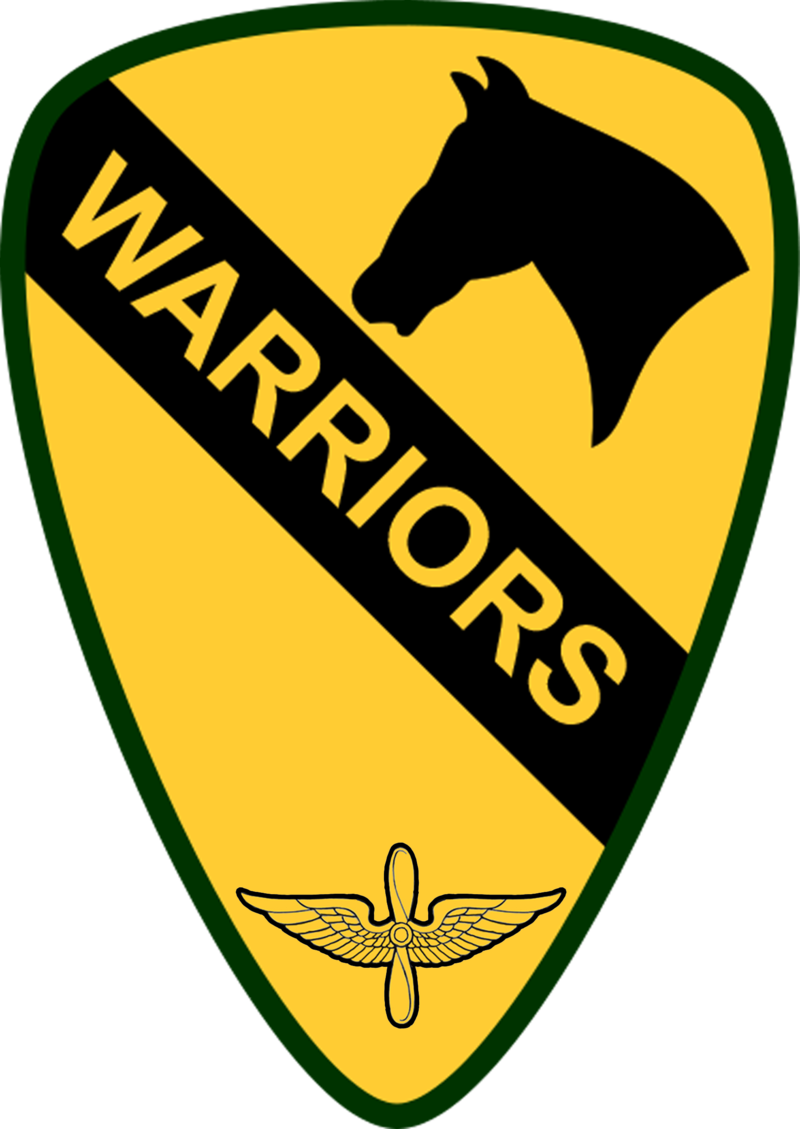
| 1st Battalion / 227th Aviation Brigade - (All Companies) | Boeing AH-64D "Apache" |
|---|---|
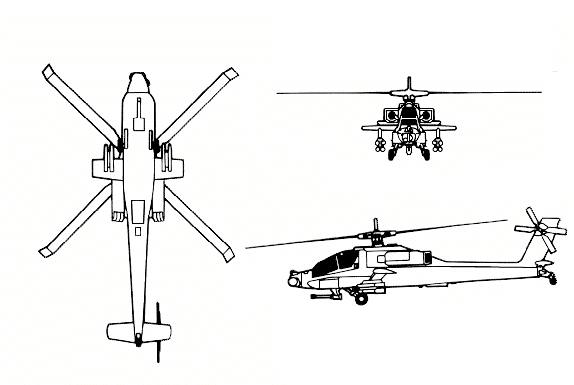 |
The Boeing AH-64 Apache is an American twin-turboshaft attack helicopter with a tailwheel-type landing gear arrangement and a tandem cockpit for a crew of two. It features a nose-mounted sensor suite for target acquisition and night vision systems. It is armed with a 30 mm (1.18 in) M230 chain gun carried between the main landing gear under the aircraft's forward fuselage, and four hardpoints mounted on stub-wing pylons for carrying armament and stores, typically a mixture of AGM-114 Hellfire missiles and Hydra 70 rocket pods. |
| General characteristics Crew: 2 (pilot, and co-pilot/gunner) Length: 58 ft 2 in (17.73 m) Fuselage length: 49 ft 5 in (15.06 m) Height: 12 ft 8 in (3.87 m) Empty weight: 11,387 lb (5,165 kg) Gross weight: 17,650 lb (8,006 kg) Max takeoff weight: 23,000 lb (10,433 kg) Powerplant: 2 × General Electric T700-GE-701 turboshaft engines, 1,690 shp (1,260 kW) each (upgraded to 1,890 shp (1,409 kW) T700-GE-701C for AH-64A/D from 1990) Main rotor diameter: 48 ft 0 in (14.63 m) Main rotor area: 1,908.5 sq ft (177.31 m2) 4-bladed main-rotor and 4-bladed tail-rotor in non-orthogonal alignment Blade section: root: HH-02; tip: NACA 64A006[354] |
Performance Maximum speed: 158 kn (182 mph, 293 km/h) Cruise speed: 143 kn (165 mph, 265 km/h) Never exceed speed: 197 kn (227 mph, 365 km/h) Range: 257 nmi (296 mi, 476 km) with Longbow radar mast Combat range: 260 nmi (300 mi, 480 km) Ferry range: 1,024 nmi (1,178 mi, 1,896 km) Service ceiling: 20,000 ft (6,100 m) Disk loading: 9.8 lb/sq ft (48 kg/m2) Power/mass: 0.18 hp/lb (0.30 kW/kg) |
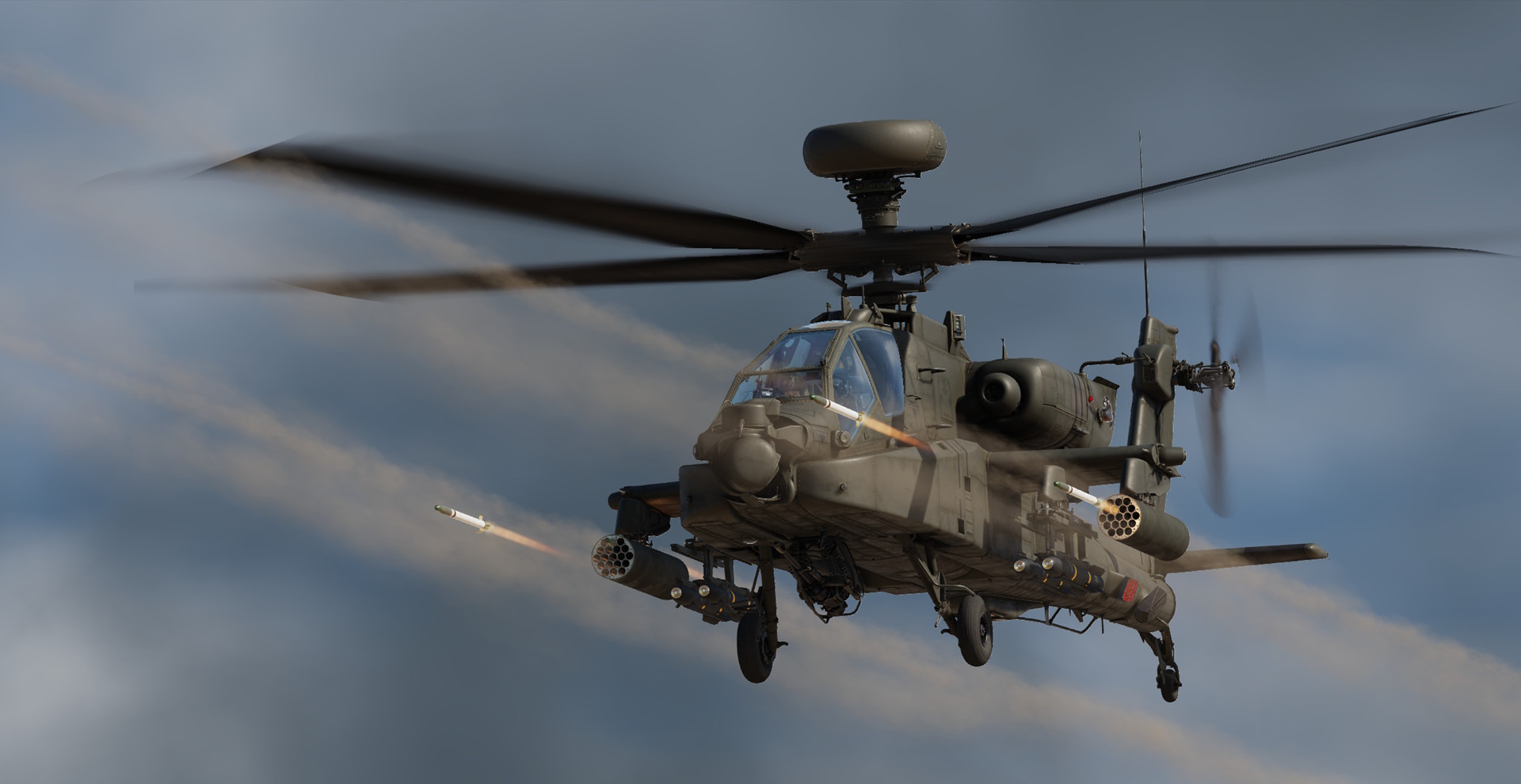
| 2nd Battalion / 227th Aviation Brigade - Alpha Company | Sikorsky UH-60L "Blackhawk" |
|---|---|
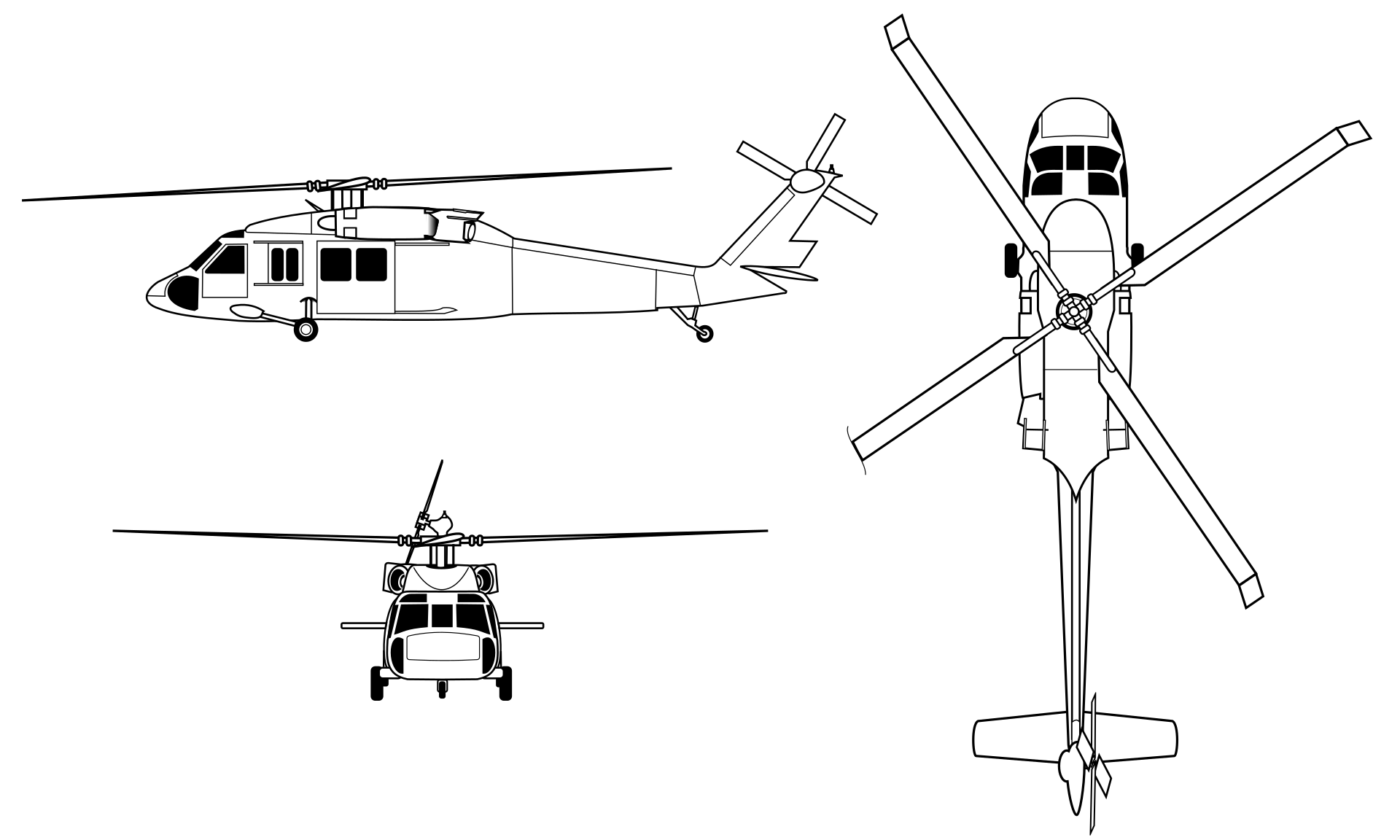 |
The Sikorsky UH-60 Black Hawk is a four-blade, twin-engine, medium-lift utility military helicopter manufactured by Sikorsky Aircraft. Sikorsky submitted the S-70 design for the United States Army's Utility Tactical Transport Aircraft System (UTTAS) competition in 1972. The Army designated the prototype as the YUH-60A and selected the Black Hawk as the winner of the program in 1976.
Named after the Native American war leader Black Hawk, the UH-60A entered service with the U.S. Army in 1979. This was followed by the fielding of electronic warfare and special operations variants of the Black Hawk. Improved UH-60L and UH-60M utility variants have also been developed. |
| General characteristics Crew: 2 pilots + 2 crew chiefs/gunners Capacity: 3,190 lb (1,450 kg) of cargo internally, including 11 seated troops or 6 stretchers, or 9,000 lb (4,100 kg) of cargo externally Length: 64 ft 10 in (19.76 m) including rotors Fuselage length: 50 ft 1 in (15.27 m) Width: 7 ft 9 in (2.36 m) Height: 16 ft 10 in (5.13 m) Empty weight: 12,511[224] lb (5,675 kg) Max takeoff weight: 22,000[224] lb (9,979 kg) Powerplant: 2 × General Electric T700-GE-701C/D turboshaft engines, 1,994 shp (1,487 kW) each Main rotor diameter: 53 ft 8 in (16.36 m) Main rotor area: 2,260 sq ft (210 m2) Blade section: root: Sikorsky SC2110; tip: Sikorsky SSC-A09[224] |
Performance Maximum speed: 159 kn (183 mph, 294 km/h) Cruise speed: 152 kn (175 mph, 282 km/h) maximum range at 18,000 lb Never exceed speed: 193 kn (222 mph, 357 km/h) Combat range: 320 nmi (370 mi, 590 km) Ferry range: 1,199 nmi (1,380 mi, 2,221 km) with ESSS stub wings and external tanks Service ceiling: 19,000 ft (5,800 m) Rate of climb: 1,646 ft/min (8.36 m/s) Disk loading: 7.19 lb/sq ft (35.1 kg/m2) Power/mass: 0.192 shp/lb (0.316 kW/kg) |
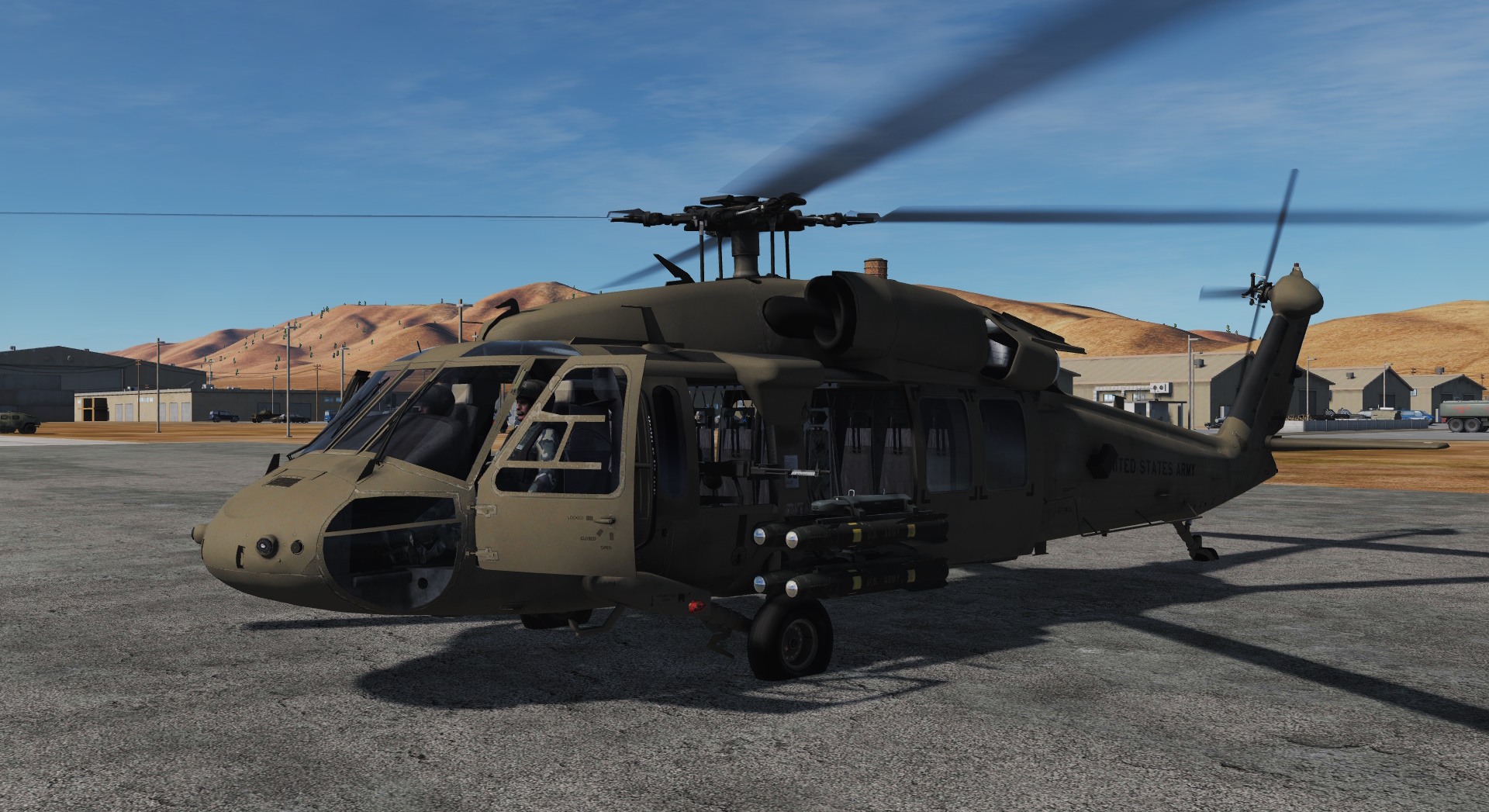
| 2nd Battalion / 227th Aviation Brigade - Bravo Company | Boeing CH-47D "Chinook" |
|---|---|
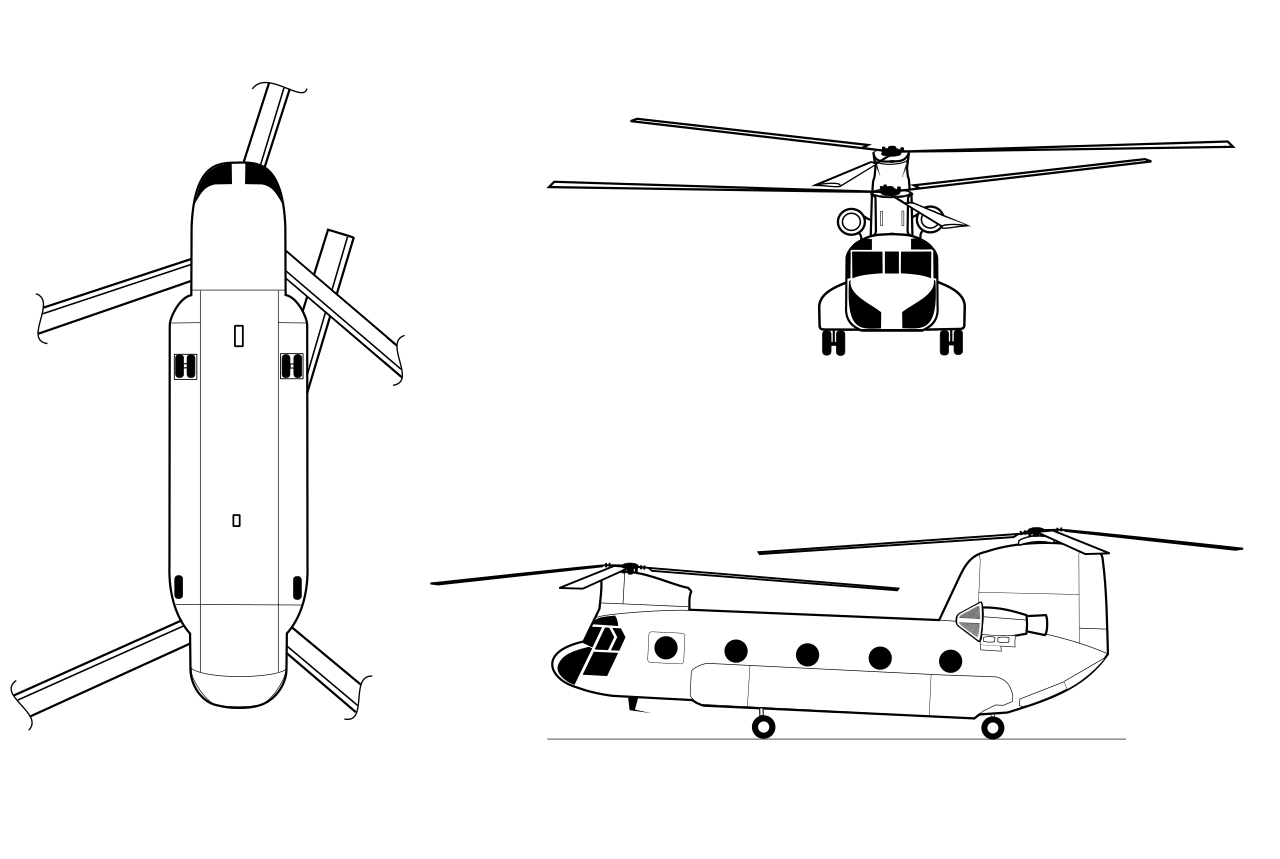 |
The Boeing CH-47 Chinook is a tandem-rotor helicopter developed by American rotorcraft company Vertol and manufactured by Boeing Vertol. The Chinook is a heavy-lift helicopter that is among the heaviest lifting Western helicopters. Its name, Chinook, is from the Native American Chinook people of Oregon and Washington state. On 21 September 1961, the Chinook performed its maiden flight, and in 1962 it was officially designated CH-47A under the 1962 United States Tri-Service aircraft designation system. |
| General characteristics Crew: 3 (pilot, copilot, flight engineer or loadmaster) Capacity: 33–55 troops or 24 stretchers and 3 attendants or 24,000 lb (10,886 kg) payload Length: 98 ft (30 m) [190] Fuselage length: 52 ft (16 m) Width: 12 ft 5 in (3.78 m) (fuselage) Height: 18 ft 11 in (5.77 m) Empty weight: 24,578 lb (11,148 kg) Max takeoff weight: 50,000 lb (22,680 kg) Powerplant: 2 × Lycoming T55-GA-714A turboshaft engines, 4,733 shp (3,529 kW) each Main rotor diameter: 2 × 60 ft (18 m) Main rotor area: 5,600 sq ft (520 m2) Blade section: root: Boeing VR-7; tip: Boeing VR-8 |
Performance Maximum speed: 170 kn (196 mph, 315 km/h) Cruise speed: 160 kn (184 mph, 296 km/h) Range: 400 nmi (460 mi, 740 km) Combat range: 200 nmi (230 mi, 370 km) Ferry range: 1,216 nmi (1,399 mi, 2,252 km) Service ceiling: 20,000 ft (6,100 m) Rate of climb: 1,522 ft/min (7.73 m/s) Disk loading: 9.5 lb/sq ft (46 kg/m2) Power/mass: 0.28 hp/lb (0.46 kW/kg) |
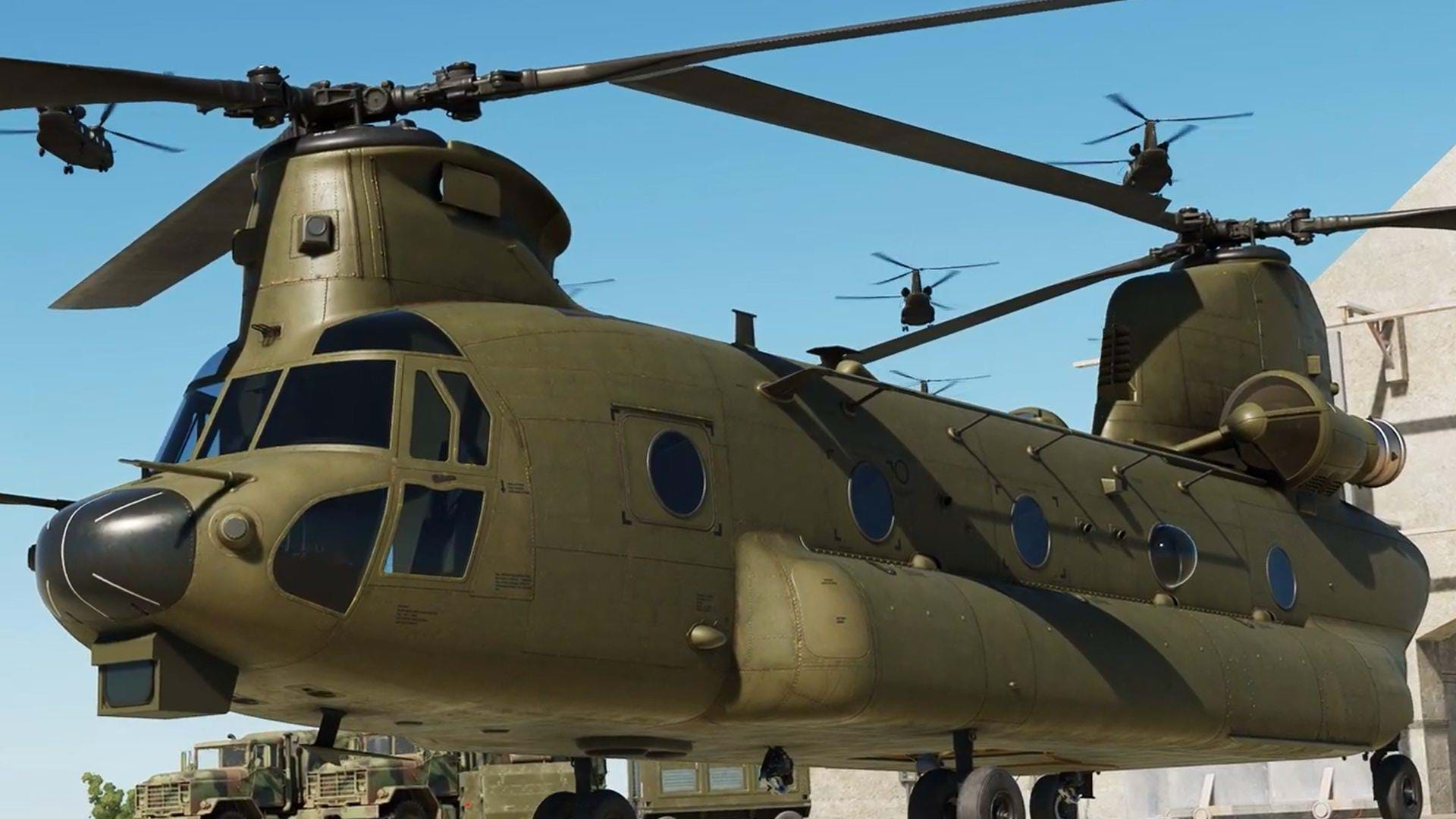
| 7th Squadron / 17th Cavalry Brigade - Alpha Troop | Bell Textron UH-1D "Iroquois" |
|---|---|
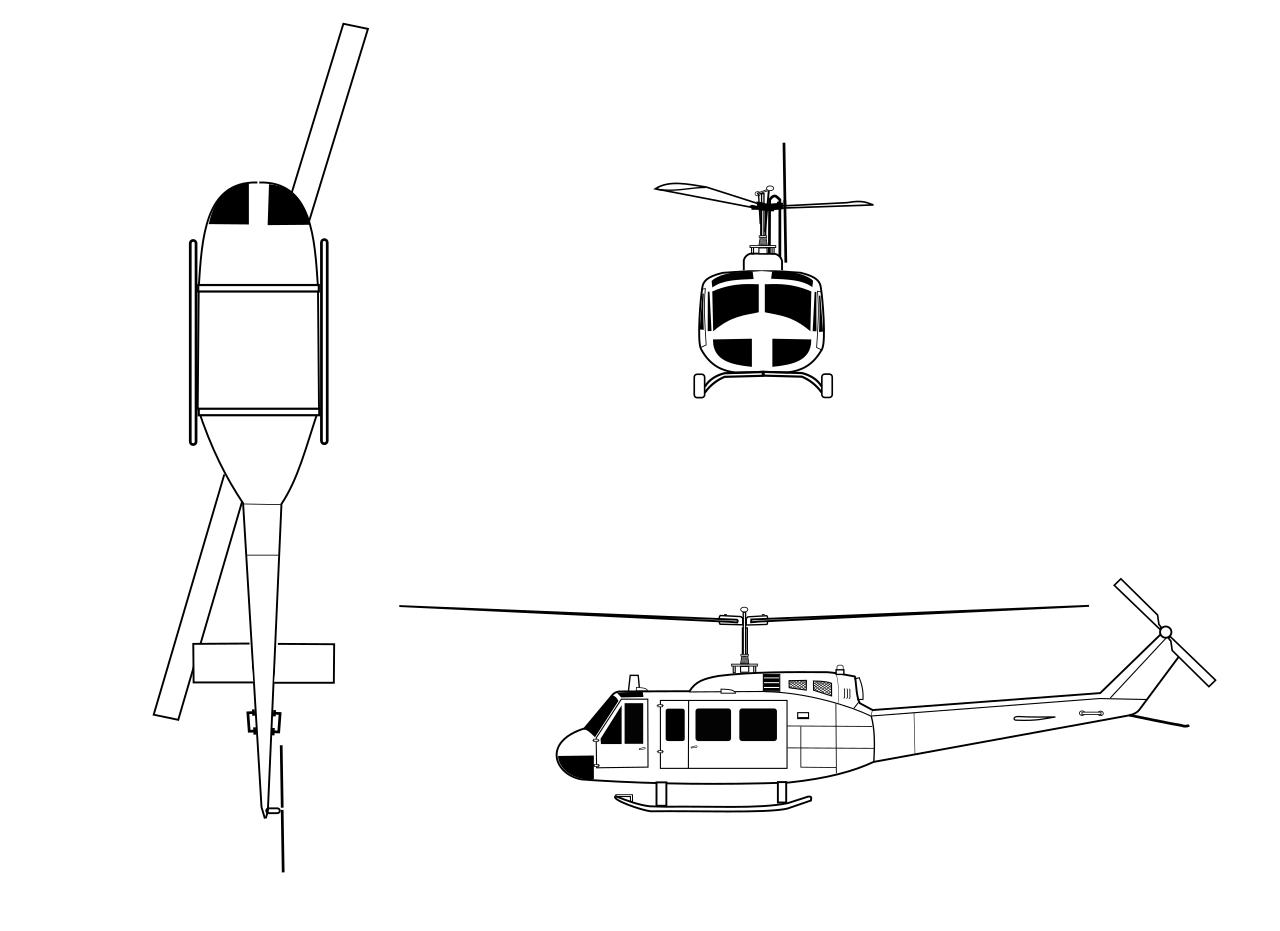 |
The Bell UH-1 Iroquois (nicknamed "Huey") is a utility military helicopter designed and produced by the American aerospace company Bell Helicopter. It is the first member of the prolific Huey family, as well as the first turbine-powered helicopter in service with the United States military. Development of the Iroquois started in the early 1950s, a major impetus being a requirement issued by the United States Army for a new medical evacuation and utility helicopter. The Bell 204, first flown on 20 October 1956, was warmly received, particularly for the performance of its single turboshaft engine over piston engine-powered counterparts. An initial production contract for 100 HU-1As was issued in March 1960. In response to criticisms over the rotorcraft's power, Bell quickly developed multiple models furnished with more powerful engines; in comparison to the prototype's Lycoming YT53-L-1 (LTC1B-1) engine, producing 700 shp (520 kW), by 1966, the Lycoming T53-L-13, capable of 1,400 shp (1,000 kW), was being installed on some models. A stretched version of the Iroquois, first flown during August 1961, was also produced in response to Army demands for a version than could accommodate more troops. Further modifications would include the use of all-aluminum construction, the adoption of a rotor brake, and alternative powerplants. |
| General characteristics Crew: 1–4 Capacity: 3,880 lb (1,760 kg) including 11-14 troops, 6 stretchers and attendant, or equivalent cargo Length: 57 ft 9+5⁄8 in (17.618 m) with rotors Width: 9 ft 6+1⁄2 in (2.908 m) (over skids) Height: 14 ft 5+1⁄2 in (4.407 m) (tail rotor turning) Empty weight: 5,210 lb (2,363 kg) Gross weight: 9,039 lb (4,100 kg) (mission weight) Max takeoff weight: 9,500 lb (4,309 kg) Powerplant: 1 × Lycoming T53-L-13 turboshaft, 1,400 shp (1,000 kW) (limited to 1,100 shp (820 kW) by transmission) Main rotor diameter: 48 ft 0 in (14.63 m) Main rotor area: 1,809.56 sq ft (168.114 m2) |
Performance Maximum speed: 127 mph (204 km/h, 110 kn) (at maximum takeoff weight; also Vne at this weight) Cruise speed: 127 mph (204 km/h, 110 kn) (at 5,700 ft (1,700 m) at maximum takeoff weight) Range: 318 mi (511 km, 276 nmi) (with maximum fuel, no reserves, at sea level) Service ceiling: 12,600 ft (3,800 m) (at maximum takeoff weight) Rate of climb: 1,600 ft/min (8.1 m/s) at sea level (at maximum takeoff weight) Disk loading: 5.25 lb/sq ft (25.6 kg/m2) Power/mass: 0.1159 hp/lb (0.1905 kW/kg) |
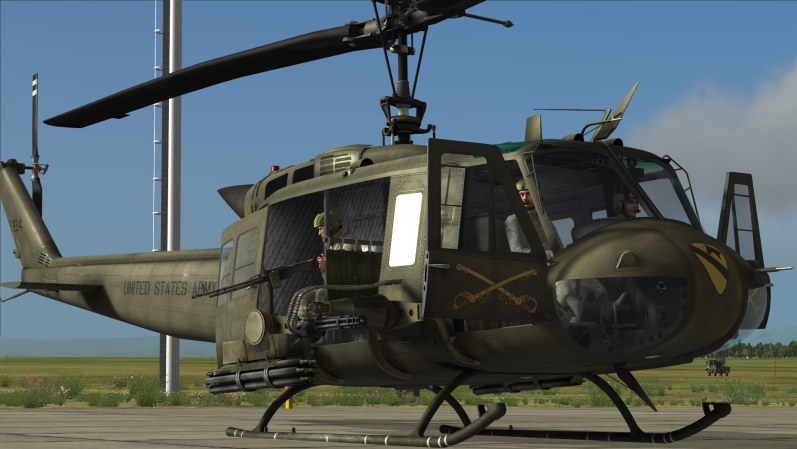
| 7th Squadron / 17th Cavalry Brigade - Bravo Troop | Bell OH-58D "Kiowa Warrior" |
|---|---|
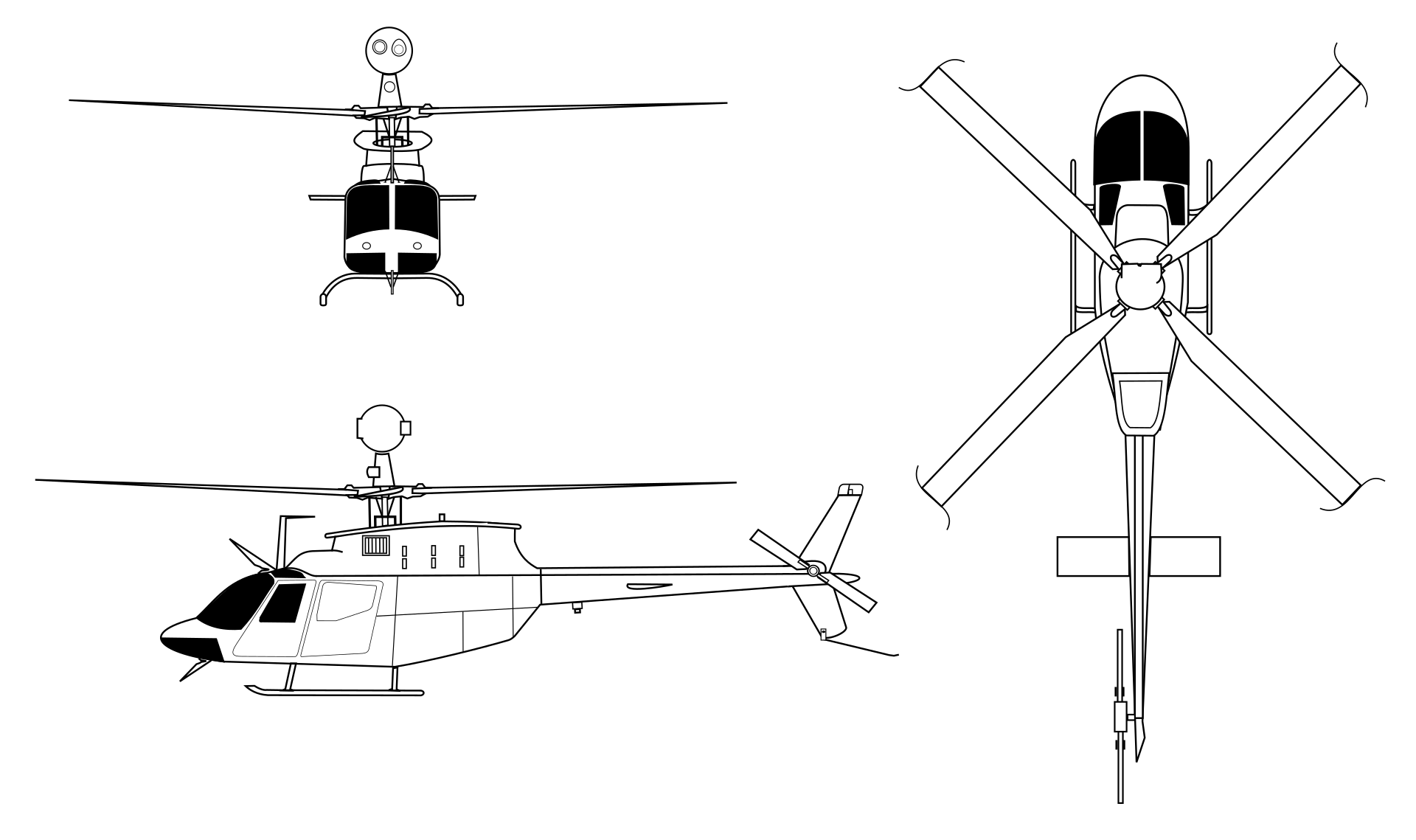 |
The OH-58D (Bell Model 406) was the result of the Army Helicopter Improvement Program (AHIP). An upgraded transmission and engine gave extra power, needed for nap-of-the-earth flight profiles, and a four-bladed main rotor made it quieter than the two-bladed OH-58C. The OH-58D introduced the distinctive Mast-Mounted Sight (MMS) above the main rotor, and a mixed glass cockpit with traditional instruments as "standby" for emergencies. The Kiowa Warrior, sometimes referred to by its acronym KW, is the armed version of the OH-58D. A key difference between the Kiowa Warrior and original AHIP aircraft is a universal weapons pylon found mounted on both sides of the fuselage, capable of carrying combinations of AGM-114 Hellfire missiles, air-to-air Stinger (ATAS) missiles, 7-shot 2.75 inches (70 mm) Hydra-70 rocket pods, and an M296 0.50 in (12.7 mm) caliber machine gun. The performance standard of aerial gunnery from an OH-58D is to achieve at least one hit out of 70 shots fired at a wheeled vehicle 800 to 1,200 m (2,600 to 3,900 ft) away. The Kiowa Warrior also includes improvements in available power, navigation, communication, survivability, and deployability. |
| General characteristics Crew: 2 pilots Length: 42 ft 2 in (12.85 m) Height: 12 ft 10 in (3.93 m) Empty weight: 3,829 lb (1,737 kg) Gross weight: 5,500 lb (2,495 kg) Powerplant: 1 × Rolls-Royce T703-AD-700A turboshaft, 650 hp (485 kW) Main rotor diameter: 35 ft 0 in (10.67 m) Main rotor area: 962.11 sq ft (89.42 m2) |
Performance Maximum speed: 149 mph (240 km/h, 129 kn) Cruise speed: 127 mph (204 km/h, 110 kn) Range: 161 mi (556 km, 140 nmi) Endurance: Two hours Service ceiling: 15,000 ft (4,575 m) |
